RESULTS OF MONITORING CHANGES IN THE SKELETON
1984 Survey
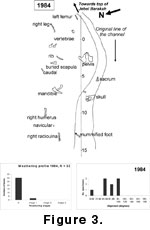 The distribution of the camel skeleton in January 1984 is shown in
Figure 3. The maximum dispersal of the skeleton was along the line of the gully over a distance of 18 m. The main concentration of bones covered an area of about 140 m2, extending 12 m along the gully bottom, with two outlier bones, a mummified foot and the right radioulna. There was little lateral movement of the bones away from the bottom of the gully.
The distribution of the camel skeleton in January 1984 is shown in
Figure 3. The maximum dispersal of the skeleton was along the line of the gully over a distance of 18 m. The main concentration of bones covered an area of about 140 m2, extending 12 m along the gully bottom, with two outlier bones, a mummified foot and the right radioulna. There was little lateral movement of the bones away from the bottom of the gully.
Several of the bones still had dried skin attached, including the radioulna, one of the detached feet and the whole of the right hind leg. Most of the bones were on the surface, but no excavation was done at this stage and it is probable that some bones were still present but buried beneath the surface. Most of the ribs and many of the vertebrae could not be found (Table 1), and it was considered likely that many had already been carried away or destroyed by scavengers. The skull was broken, with the braincase missing, but the mandible was intact. Both right legs were preserved but lacking the right scapula, but both left legs were missing except for the left femur, which was the most extensively broken bone in the skeleton. The left scapula was present, half buried. It would seem that the dead animal had been lying on its right side, protecting the right limbs from scavengers but leaving the left side exposed. Orientations of the bones were influenced by their position on the surface (Figure 3), the bones on the north side of the gully aligned to the south and west, at 221º to 280º, following the slope of the side of the gully towards the channel. (Bones with equal but opposite direction are combined so that the scale on
Figure 3 is shown from 0 to 180º.)
There was little in the way of surface modifications on the bones. Two bones have very slight etching of the surface, mainly because they were stabilised in the ground. The scapula, for example, was half buried, and the top of the scapular spine showed a very early stage of weathering, intermediate between 0 and 1 in
Behrensmeyer's (1978) scale (Figure 3). The pelvis, like the scapula, provides a wide surface area to weathering, and since the two sides were still in articulation, it could not easily be turned over, so that the exposed side showed the same early stage of weathering. No evidence of carnivore chewing was seen at this stage, which is puzzling since many of the ribs and vertebrae were missing. It will be seen later that both rib and vertebra numbers were higher in later surveys, and the most likely solution is that the bones were there but buried beneath drifting sand.
1992 Survey
 Just over eight years after first discovery, the camel skeleton was mapped again and some bones collected on April 12, 1992. The extent of the main bone cluster was little changed (Figure 4), with the scatter extending about 10 m along the axis of the gully, but the position of the channel had changed. Whereas before it had curved around the position of the pelvis (Figure 3), it now passed right through this position, splitting the pelvis into two halves, one on each side of the channel. It is odd that both fragments remained on the banks above the channel, neither falling into the channel itself. This suggests that the water flow was not excessively fast.
Just over eight years after first discovery, the camel skeleton was mapped again and some bones collected on April 12, 1992. The extent of the main bone cluster was little changed (Figure 4), with the scatter extending about 10 m along the axis of the gully, but the position of the channel had changed. Whereas before it had curved around the position of the pelvis (Figure 3), it now passed right through this position, splitting the pelvis into two halves, one on each side of the channel. It is odd that both fragments remained on the banks above the channel, neither falling into the channel itself. This suggests that the water flow was not excessively fast.
The skull had disintegrated, leaving only two maxillary fragments, one of which was collected (Figure 5), and some skull fragments that had moved up the gully, probably carried by a scavenger. One of the maxillary fragments was in the bottom of the channel partly buried, and the other was on the platform above the channel.
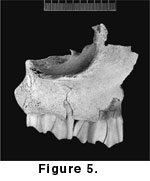 The pelvis had been split in two as mentioned above, and one of the scapulae was found half buried in the bottom of the channel (it is likely that this was the left scapula recorded outside the channel in 1984, but our records do not show which side it was from - see below). More ribs were seen on this occasion, five in all, and four vertebrae that were extremely broken up. Some of the bones from the previously articulated leg were still in the same place, with the tibia, metatarsal and calcaneus/astragalus still being present. No forelimb elements were seen, apart from the scapula just mentioned, and the mandible had disappeared, as had the sacrum and the mummified foot. Bone orientations were similar to those seen in 1984, with directions being determined by the slope of the land westwards along the line of the gully and (on the north side of the gully) southwards towards the channel running down the middle of the gully (Figure 4).
The pelvis had been split in two as mentioned above, and one of the scapulae was found half buried in the bottom of the channel (it is likely that this was the left scapula recorded outside the channel in 1984, but our records do not show which side it was from - see below). More ribs were seen on this occasion, five in all, and four vertebrae that were extremely broken up. Some of the bones from the previously articulated leg were still in the same place, with the tibia, metatarsal and calcaneus/astragalus still being present. No forelimb elements were seen, apart from the scapula just mentioned, and the mandible had disappeared, as had the sacrum and the mummified foot. Bone orientations were similar to those seen in 1984, with directions being determined by the slope of the land westwards along the line of the gully and (on the north side of the gully) southwards towards the channel running down the middle of the gully (Figure 4).
No soft tissue was present, and the majority of specimens still showed no evidence of weathering. The scapula had early stage 1 weathering along the scapular spine, the only part exposed. The right pelvis also showed early stage 1 weathering, with no weathering on the protected side and early stage 1 on the exposed side. The maxilla had no evidence of weathering on the internal, lingual side, but stage 1 weathering on most of the exposed buccal side, with fine cracking along planes of weakness (Figure 5). Nearly one quarter of the bones had incipient or full stage 1 weathering compared with 6% in 1984 (Figure 4).
1994 Survey
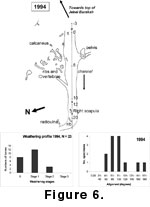 Two years later on April 8, 1994, the bone cluster was still intact, but some of the bones had been moved some distance down the gully (Figure 6). The right scapula was seen for the first time, in the channel 13.5 m down the gully from the main bone cluster. By an unfortunate omission, the scapula seen in the channel in 1992 (see above) did not have its side recorded, and so it is not certain if this is the same specimen moved 9.3 m down the channel (in 1992 it was at 4.2 m - see
Figure 4) or if it had been moved earlier and buried, so that it was not seen until 1994. There were also two intact ribs not seen in previous surveys, both 21 m down the channel. Neither of the ribs was broken and neither had been visible in earlier surveys. It is presumed that they were buried in the channel deposits, and this might suggest that both they and the scapula had been transported down the channel at an earlier time. The radioulna was located 24 m down the gully just off to the side of the main channel (Figure 6), and at 30 m was one of the fragments of maxilla. Bone orientations were again similar to those seen in 1984 and 1992, with directions being determined by the slope of the land westwards along the line of the gully and (on the north side of the gully) southwards towards the channel running down the middle of the gully (Figure 6).
Two years later on April 8, 1994, the bone cluster was still intact, but some of the bones had been moved some distance down the gully (Figure 6). The right scapula was seen for the first time, in the channel 13.5 m down the gully from the main bone cluster. By an unfortunate omission, the scapula seen in the channel in 1992 (see above) did not have its side recorded, and so it is not certain if this is the same specimen moved 9.3 m down the channel (in 1992 it was at 4.2 m - see
Figure 4) or if it had been moved earlier and buried, so that it was not seen until 1994. There were also two intact ribs not seen in previous surveys, both 21 m down the channel. Neither of the ribs was broken and neither had been visible in earlier surveys. It is presumed that they were buried in the channel deposits, and this might suggest that both they and the scapula had been transported down the channel at an earlier time. The radioulna was located 24 m down the gully just off to the side of the main channel (Figure 6), and at 30 m was one of the fragments of maxilla. Bone orientations were again similar to those seen in 1984 and 1992, with directions being determined by the slope of the land westwards along the line of the gully and (on the north side of the gully) southwards towards the channel running down the middle of the gully (Figure 6).
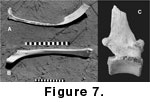 The main bone cluster consisted of ribs and vertebrae. There were nine rib fragments, two of which were exposed on the surface and the others were partly buried so that it could not be determined how complete they were. There were seven vertebrae still relatively complete (Figure 7), and one calcaneus still close to the position of the left leg but now all that remained of the leg. The remains of the pelvis were still on the south side of the channel, and part of this was collected for further examination.
The main bone cluster consisted of ribs and vertebrae. There were nine rib fragments, two of which were exposed on the surface and the others were partly buried so that it could not be determined how complete they were. There were seven vertebrae still relatively complete (Figure 7), and one calcaneus still close to the position of the left leg but now all that remained of the leg. The remains of the pelvis were still on the south side of the channel, and part of this was collected for further examination.
Modifications of the bones were greater than was observed in the 1992 survey. More than half the bones had now reached stage 1 weathering, three were at stage 2, but a significant minority of bones still showed no evidence of weathering (Figure 6). The pelvis fragment had the top edge of the ilium extensively broken, probably as a result of trampling by camels and goats that graze in this area. No carnivore damage was seen, and weathering was at an early stage, fine splitting but no flaking, indicating stage 1 weathering. No sign of the other half of the pelvis, which previously had been present on the north side of the channel, was seen. The radioulna had evidently been mobile, given its position down the gully, and it was evenly weathered on all surfaces at early stage 1 (Figure 7). The ribs and vertebrae were assessed for weathering but only one of each was collected at this stage. In general they had low levels of weathering, stage 1 for the most part but with areas of flaking indicating early stage 2 weathering (Figure 7). The parts of the bones that were buried, even under a few millimetres of sand, had no weathering and were stained light brown in contrast to the bleached white of the exposed bone. The exposed part of the vertebra had extensive splitting and early stages of flaking, while on projecting processes the flaking goes deeper, producing roughened patches of bone greater than 10 mm2, and so by definition it is at stage 2 even though most of the surface is minimally weathered. The maxilla had no weathering on the internal, lingual side, but stage 1 weathering on most of the exposed buccal side, with fine cracking along planes of weakness. There was localised flaking on the thin alveolar bone covering the tooth roots and on the diastema, so that this specimen could be categorised as early stage 2. The teeth also show evidence of cracking and splitting of enamel. There was limited carnivore damage along the broken upper edge where a series of small punctures ranging from 1.4 to 3.2 mm in diameter occurred along the broken edge.
1995 Collection
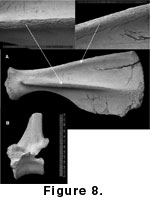 No survey was done this year, but two more bones were collected on March 6, 1995, for examination in the laboratory. These were the right scapula and another vertebra. The scapula had no weathering on the side in contact with the substrate, but the upper, dorsal, side had variable weathering, ranging from stage 1 over much of the scapular blade to extensive flaking along the spine and along the vertebral edge (Figure 8), indicating stage 2/3 weathering. The vertebra was complete except for one of the lateral processes (Figure 8). It had moved around on the surface so that the degree of weathering was similar on all surfaces. Extensive splitting was present with localised flaking, and the top of the vertebral spine showed deeper and more extensive flaking, so that this bone can be characterised as mainly stage 2 with beginning stage 3. Carnivore damage was seen on the broken process, and there were also chewing marks on the end of the unbroken lateral process, giving a range of pit diameters from 1.4 to 2.1 mm (see
below).
No survey was done this year, but two more bones were collected on March 6, 1995, for examination in the laboratory. These were the right scapula and another vertebra. The scapula had no weathering on the side in contact with the substrate, but the upper, dorsal, side had variable weathering, ranging from stage 1 over much of the scapular blade to extensive flaking along the spine and along the vertebral edge (Figure 8), indicating stage 2/3 weathering. The vertebra was complete except for one of the lateral processes (Figure 8). It had moved around on the surface so that the degree of weathering was similar on all surfaces. Extensive splitting was present with localised flaking, and the top of the vertebral spine showed deeper and more extensive flaking, so that this bone can be characterised as mainly stage 2 with beginning stage 3. Carnivore damage was seen on the broken process, and there were also chewing marks on the end of the unbroken lateral process, giving a range of pit diameters from 1.4 to 2.1 mm (see
below).
1998 Survey
In 1998 we made one last survey of the camel skeleton on November 6 and collected all the bones we could find, both above and below ground, although we did not carry out a systematic excavation. Altogether we found eight vertebrae, part of the pelvis, two ribs, two phalanges, a calcaneus and an astragalus. None of the long bones were found and no trace of any cranial element, neither teeth nor mandibles. There had been considerable drifts of sand blown over the area, however, and it is likely that several elements were preserved buried under considerable depths of sand.
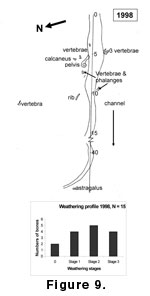 The distribution of bones (Figure 9) indicates that there had been a general movement of bones down the channel. The bones seen previously 20 to 24 m down channel had disappeared, and now there was a single bone 45 m down the channel, the astragalus, which previously had remained with the cluster of bones at the death site. The pelvis on the north side of the channel, seen previously in 1992 but not in 1994, was found, but the other half of the pelvis on the south side of the channel had disintegrated in 1994 and the remaining parts collected that year. The calcaneus remained in the bone cluster, but 5 m down slope from the place where the left leg had last been seen. Only two bones could be measured for orientation, and these were non-conclusive.
The distribution of bones (Figure 9) indicates that there had been a general movement of bones down the channel. The bones seen previously 20 to 24 m down channel had disappeared, and now there was a single bone 45 m down the channel, the astragalus, which previously had remained with the cluster of bones at the death site. The pelvis on the north side of the channel, seen previously in 1992 but not in 1994, was found, but the other half of the pelvis on the south side of the channel had disintegrated in 1994 and the remaining parts collected that year. The calcaneus remained in the bone cluster, but 5 m down slope from the place where the left leg had last been seen. Only two bones could be measured for orientation, and these were non-conclusive.
Overall, some bones had now reached stage 3 weathering, and the majority were at stages 1 and 2 (Figure 9), but it is difficult to generalize since so much depends on the degree to which the bones had been buried and thus protected from both dispersal and weathering. Four categories of bones could be identified:
-
Bones buried for the whole monitoring period, from 1974 to 1998, and not seen until the final clearing of the site. For example, the small cluster of vertebrae on the south side of the channel at 4.6 m along the datum line (Figure 9) were found below the surface; they were stained light brown in colour; they had extensive root marking on all surfaces; and they showed little evidence of weathering, having light cracking following the fibre structure of the bones. One of the vertebrae had the surface bone heavily modified by chemical corrosion resulting from the extensive root etching similar to, but not as extreme, as that shown in
Andrews (1990, figure
1.11A). This type of surface degradation arising from chemical processes below the ground results from subsurface weathering in that it is the consequence of temperature and moisture fluctuations in a biologically active soil. It has different effects on the bone from surface weathering as defined by
Behrensmeyer (1978).
-
Some bones were partly buried and were visible on the surface of the ground, and they had differential weathering on their two surfaces. One side was stained light brown as seen above, and this side usually also had root marks and low levels of weathering. The other side of the same bone was either unstained or lightly stained and typically had extensive splitting and some flaking of surface bone, identified as stage 2 weathering following
Behrensmeyer (1978). The topmost vertebra in the cluster mentioned above was in this position, as was the isolated vertebra 9 m to the north of channel (Figure 9).
-
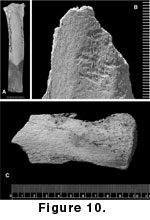 Two ribs had one end or one corner buried and the rest of the bone exposed at the surface. The buried end was stained as above, and it showed little evidence of weathering, while the exposed end had extensive cracking and flaking consistent with stage 2-3 weathering (Figure 10).
Two ribs had one end or one corner buried and the rest of the bone exposed at the surface. The buried end was stained as above, and it showed little evidence of weathering, while the exposed end had extensive cracking and flaking consistent with stage 2-3 weathering (Figure 10).
-
Several bones had never been buried at any stage. For example, the calcaneus from the left leg had been seen on every occasion the camel skeleton was surveyed, and it moved very little from its original resting place. It was weathered on all surfaces, with extensive splitting and flaking of bone along the bottom edge and processes, stage 3 at least, and it had no staining or root marks (Figure 10). On the other hand, the half pelvis recovered from the north side of the channel had fine splitting and minor flaking over the whole surface at stage 1 only, yet it had been exposed on the surface for the whole period of the survey.
One additional observation concerns the astragalus found 45 m down the wadi bottom (Figure 9). This specimen was not stained and had no root marks, but it showed only very early stages of stage 1 weathering. It was not seen during earlier surveys, and it is possible that it is intrusive, carried there from another skeleton. If it belongs to the monitored skeleton, it may have in fact been buried for much of the 15 years of the monitoring, but some time between 1994 and 1998, the years of the last two surveys, it was washed out of its burial place and transported down the wadi. During this period of up to four years it was exposed to the elements and any staining was removed.

 The distribution of the camel skeleton in January 1984 is shown in
Figure 3. The maximum dispersal of the skeleton was along the line of the gully over a distance of 18 m. The main concentration of bones covered an area of about 140 m2, extending 12 m along the gully bottom, with two outlier bones, a mummified foot and the right radioulna. There was little lateral movement of the bones away from the bottom of the gully.
The distribution of the camel skeleton in January 1984 is shown in
Figure 3. The maximum dispersal of the skeleton was along the line of the gully over a distance of 18 m. The main concentration of bones covered an area of about 140 m2, extending 12 m along the gully bottom, with two outlier bones, a mummified foot and the right radioulna. There was little lateral movement of the bones away from the bottom of the gully.





